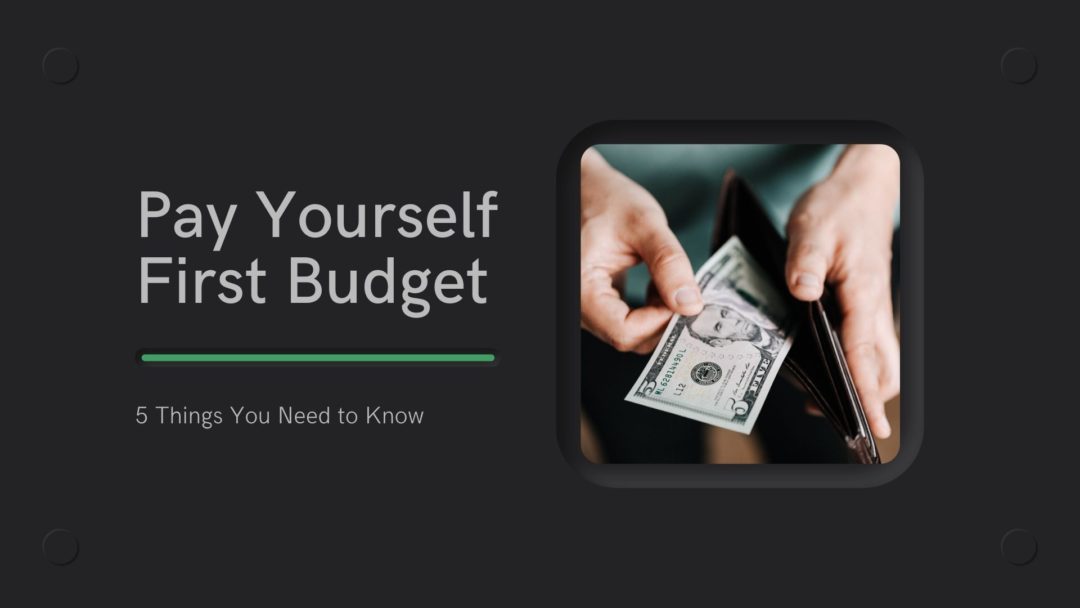
The Pay Yourself First Budget is a system that flips your typical budget upside down. Also known as a reverse budget, here is what you should know before deciding if this is right for you and your finances.
What is the Pay Yourself First Budget?
As previously mentioned, the Pay Yourself First Budget is a type of reverse budgeting system. Here, instead of prioritizing your expenses as you would in your typical budget, you are instead putting primary focus on building your savings. Like many other ways of budgeting, you’re still utilizing the 50/30/20 rule, however, instead of first thinking about your 50 percent allocated to needs and 30 percent allocated to wants, you will be putting that 20 percent to savings and debt payments at the forefront of your mind.
The Pay Yourself First Budget requires a change in both the way you think about your money and a shift in how you’re spending. It is not telling you to invest in your savings and only your savings, and to forget the other collective 80 percent. Instead it is about telling yourself and believing that you are worth the monetary investment and prioritization.
What Are the Benefits of the Pay Yourself First Budget?
Rethinking the way you budget your money will only benefit you in the end. To determine the benefits of the Pay Yourself First Budget, you will first need to do a deep dive of your spending habits. This means actually opening the statement your bank sends you in the mail or emails you every month and actually seeing where your money is going. Afterall, that is the purpose of a budget in the first place.
After your deep dive, you can determine how closely you are following that 50/30/20 rule and if you even are focusing on savings at all. What many people love about the Pay Yourself First Budget is that it allows them to keep their financial goals at the forefront of their minds and makes them feel like they were making progress towards those goals. So be it saving for retirement or saving up to take a nice vacation, the Pay Yourself First Budget will help you dial in on and reach your goals.
What Type of Person is the Pay Yourself First Budget Best For?
Many people can make the Pay Yourself First Budget work for them. However, there are some who will find it more helpful than others. This type of budgeting works best for those who have a specific financial goal in mind. The financial goal you set for yourself can be dependent on the stage of life you’re in. Still, having even a vague idea of what you want to save toward can help you. For example, if your goal is to buy a home and get out of the renting cycle, the Pay Yourself First Budget can help you put the appropriate amount of money you need aside while you learn how much house you can afford.
Pay Yourself First can also be beneficial to people nearing the age of retirement. By looking at what you’ve already saved and then prioritizing your retirement savings even more with Pay Yourself First Budgeting, you will be better setting yourself up to be more comfortable in retirement. This is especially true if you haven’t been able to save as much as you should toward retirement and is a good focus if you got a later start at saving for retirement.
What Are the Disadvantages of the Pay Yourself First Budget?
The Pay Yourself First Budget assumes that you have low debt. This is problematic especially for the large generation of those who owe massive amounts of student loan debt. If you are in a large amount of debt, then putting a decent, if any, amount of money aside can be extremely challenging. It’s still possible to see value in this method of budgeting; however, with you putting less money aside, it could take longer to reach your savings goals due to the debt you face.
Couples can also find difficulty in the Pay Yourself First Budget. In a relationship, you’re merging two potentially different ways of looking at saving and spending money. This is only one of the reasons why managing money in a relationship can be difficult, but not impossible. With Pay Yourself First, you’re looking at your personal finances and your personal goals. In a relationship, you have to multiply that times two and make sure both parties are on the same page and will stick to the budgeting system. There is plenty of reward if it pays off, but also plenty of ways to be sidetracked.
What Are the Alternative Budget Strategies?
It’s important that the budget you’re using meets your needs and situation. If you try and then find that Pay Yourself First isn’t working for you, but you still want to try some form of budgeting, there are plenty of alternative strategies out there for you to try.
- The Envelope System – This approach is cash-based and based on the old-school way of putting money aside. There is no doubt that this approach will bring back memories of stories you were told about your grandparents and great-grandparents stuffing money away in various odd places throughout their homes. The Envelope System is a strict and rigid approach to budgeting where you set an allowance for each of your expense categories, put that allowed money in an envelope, and use only that money for its assigned expense.
- The Zero-Based Budget – Utilizing this approach is best when you know exactly how much you are making in a given month. Having that total allows you to allocate your savings and expenses until that total subtracted from your income equals zero. In other words, your monthly income amount should be equal to your monthly savings and spending amount. This budget leaves no room for error and demands 100 percent accuracy in all areas. However, the reward for your accuracy is not having to worry about making up the difference.
- The 60% Solution – Similar to the 50/30/20 rule, this budgeting system relies on percentages to help you budget and save. Here, 60 percent of your income should go toward your committed expenses. This includes the bills that you pay every month like housing, food, insurance, bills, etc. That leftover 40 percent gets divided into four categories that are each allocated 10 percent of your income. These categories are: retirement funds, long-term savings like an emergency fund and standard stock purchases, short-term savings like vacations and other bigger expenses, and wants like eating at a restaurant.
- The No Budget – The key word here is “no”. Here you aren’t necessarily creating a budget, and instead being cognizant of the money you do have to not spend money you don’t have. This leaves you heavily reliant on your banking app so you can monitor your checking account and always be aware of how much is in there. Knowing how much you have and how much you need to meet your expenses allows you to reasonably say “no” to what you don’t have money for. Of course telling yourself “no” is sometimes easier said than done.
Having a budget is an important part of your personal finances. Whether you’re using a reverse budget that changes the way you think about your money like the Pay Yourself First Budget or you’re trying something different, the important thing is that you’re doing what’s best for you and your goals. Finding what works for you can take time, but it’s important that you stick to it and give the system time to work for you. If, after some time, you’re not seeing the progress you want, reevaluate your current plan for anything you missed and then try something new.


